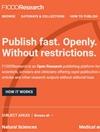Planet activeness: a new concept to enhance the accuracy of Astromet weather forecast.
Q2 Pharmacology, Toxicology and Pharmaceutics
引用次数: 0
Abstract
Background Astrometeorology is an ancient science, that deals the relationship between planet position and weather events. Several Indian studies proved that Astrometeorology could be a complementary method to improve numerical weather forecast accuracy. Since 2011, Tamil Nadu Agricultural University is conducting astrometeorological research and devised a novel concept “Planet Activeness Chart”. The principle is that “planets’ influence on a location’s weather varies throughout the day and may be negative, inactive, active, highly active and rule depending on their angle to that location”. Most existing astromet studies used planetary position to predict the occurrence of weather events (yes/no) but failed to capture intensity of the event. The “Planet Activeness Concept” could address this limitation and enhance forecast usability. Methods A study was carried out from 2018 to 2021 with six years data (2011-16) to verify the “Planet activeness” on hourly rainfall and windspeed events in Tamil Nadu. The frequency of planet activeness for a weather event was calculated by dividing the number of times a planet was in the selected activeness during a specific event category by the total number of events. Results The results indicated that negative state of the Sun, active status of the Saturn, Uranus, Venus and Moon were positively associated with rainfall intensity. The windy planet Mercury and Neptune at active state, the Sun and Saturn at rule state, Venus and Uranus at negative state, Jupiter at highly active state had significant influence on the increased wind speed. Conclusion Applying the planet activeness concept with azimuth could enhance the accuracy and usability of Astrometeorological forecasts. This study establishes a mathematical relationship between planet activeness and weather as a first step to understand the science behind this relationship. It is suggested to study different combination of planet activeness during a weather event for more insights.行星活动性:提高 Astromet 天气预报准确性的新概念。
背景 天文气象学是一门古老的科学,研究行星位置与天气事件之间的关系。印度的一些研究证明,天体气象学是提高数值天气预报准确性的一种补充方法。自 2011 年起,泰米尔纳德邦农业大学开始进行天体气象学研究,并设计了一个新概念 "行星活动图"。其原理是 "行星对某地天气的影响在一天中各不相同,可能是负面的、不活跃的、活跃的、高度活跃的和规则的,这取决于它们与该地的角度"。现有的大多数天体行星研究使用行星位置来预测天气事件的发生(是/否),但未能捕捉到事件的强度。行星活动性概念 "可以解决这一局限性,并提高预报的可用性。方法 利用 2018 年至 2021 年的六年数据(2011-16 年)开展了一项研究,以验证 "行星活跃度 "对泰米尔纳德邦每小时降雨和风速事件的影响。天气事件中行星活跃度的频率是通过将行星在特定事件类别中处于选定活跃度的次数除以事件总数计算得出的。结果表明,太阳的负面状态,土星、天王星、金星和月亮的活跃状态与降雨强度呈正相关。处于活跃状态的多风行星水星和海王星、处于规则状态的太阳和土星、处于负状态的金星和天王星、处于高度活跃状态的木星对风速增加有显著影响。结论 将行星活跃度概念与方位角结合起来,可以提高天文气象预报的准确性和可用性。这项研究建立了行星活跃度与天气之间的数学关系,为了解这种关系背后的科学原理迈出了第一步。建议对天气事件中行星活动性的不同组合进行研究,以获得更多见解。
本文章由计算机程序翻译,如有差异,请以英文原文为准。
求助全文
约1分钟内获得全文
求助全文
来源期刊

F1000Research
Pharmacology, Toxicology and Pharmaceutics-Pharmacology, Toxicology and Pharmaceutics (all)
CiteScore
5.00
自引率
0.00%
发文量
1646
审稿时长
1 weeks
期刊介绍:
F1000Research publishes articles and other research outputs reporting basic scientific, scholarly, translational and clinical research across the physical and life sciences, engineering, medicine, social sciences and humanities. F1000Research is a scholarly publication platform set up for the scientific, scholarly and medical research community; each article has at least one author who is a qualified researcher, scholar or clinician actively working in their speciality and who has made a key contribution to the article. Articles must be original (not duplications). All research is suitable irrespective of the perceived level of interest or novelty; we welcome confirmatory and negative results, as well as null studies. F1000Research publishes different type of research, including clinical trials, systematic reviews, software tools, method articles, and many others. Reviews and Opinion articles providing a balanced and comprehensive overview of the latest discoveries in a particular field, or presenting a personal perspective on recent developments, are also welcome. See the full list of article types we accept for more information.
 求助内容:
求助内容: 应助结果提醒方式:
应助结果提醒方式:


